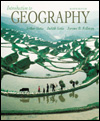 |  Introduction to Geography, 8/e Arthur Getis,
San Diego State University
Judith Getis
Jerome D. Fellmann,
University of Illinois, Urbana-Champaign
Introduction
ProblemsWeb Page Questions:
Answer the following questions using the web pages listed in the chapter.
- The Association of American Geographers - http://www.aag.org
a. If you are specializing in regional geography, where might you find
employment? __________________________________________________________________________________________
__________________________________________________________________________________________
b. How might you determine if you want to be a geographer? __________________________________________________________________________________________
__________________________________________________________________________________________
- Michigan State University - http://www.ssc.msu.edu/ (Note: One enters
through the university's homepage and clicks on Departments.)
By perusing this web site, what impression do you get about the popularity of geography
related web sites? __________________________________________________________________________________________
- Refer to site
www.ncge.org
The National Council for Geographic Education (NCGE) web site contains
information about the national standards for geography in the Goals 2000 - Educate America Act.
- What does a 4th grade student have to be able to ask?
- How is an 8th grade student supposed to organize geographic
information?
- How is a 12th grade student supposed to answer geographic questions?
Problems: 1. Consult an encyclopedia article on the history of geography. Annotate the
time lines below to include important events and periods of Classical Geography
(beginning of recorded time to the end of the Renaissance Period/Age of Exploration)
and Modern Geography from the 1700s to the present.  <a onClick="window.open('/olcweb/cgi/pluginpop.cgi?it=jpg::Time Lines::/sites/dl/free/0072367229/9461/Image01_01.jpg','popWin', 'width=558,height=158,resizable,scrollbars');" href="#"><img valign="absmiddle" height="16" width="16" border="0" src="/olcweb/styles/shared/linkicons/image.gif">Time Lines (20.0K)</a>Time Lines <a onClick="window.open('/olcweb/cgi/pluginpop.cgi?it=jpg::Time Lines::/sites/dl/free/0072367229/9461/Image01_01.jpg','popWin', 'width=558,height=158,resizable,scrollbars');" href="#"><img valign="absmiddle" height="16" width="16" border="0" src="/olcweb/styles/shared/linkicons/image.gif">Time Lines (20.0K)</a>Time Lines2. Geographic Education is now an integral part of the K-12 curriculum of the
American educational system. The inclusion of geography in the Goals 2000 national
education program reflects the conviction that knowledge of geographic principles
and the ability to use geographic techniques are essential to all Americans.
A geographic literate person understands the 18 national standards included
under the six major categories. Look through all chapters of this book and write
down the numbers of at least two illustrations for each standard that exemplify
one or more of these standards. Be sure to select illustrations from all chapters.
For example, the standard: How to use maps and other geographic representations,
tools, and technologies to acquire, process, and report information for a spatial
perspective is illustrated by Figure 2.18. Critical Thinking Questions - The study areas of geography can be likened to gears, each rotating independently,
yet linked by interlocking cogs. The cogs of the gears represent study areas
within geography and come together in a variety of ways. Using this analogy,
give six different examples of how Gear A "Systematic or Topical Studies,"
Gear B "Regional or Area Studies," and Gear C "Geographic Techniques
and Skills" interact to create unique problem sets for geographers.
- Using the 18 National Geography Standards as a guide, how would you explain
to a 6th grade student the importance of geography in his or her
life?
- Under the "geography" entry of an encyclopedia, look up additional
information on any two geographers listed in this entry. Write a short biography
of each person, focusing on the contribution made to the field of study.
- Under the "exploration, geographic" entry of an encyclopedia,
look up additional information on any two explorers listed in this entry.
Write a short biography of each person, focusing on the contribution made
to increasing our knowledge of the earth.
- In the history of geography, the 1980s in America saw a "back to basics" movement develop and evolve. Why was this necessary? What influence has it
had on the American education system's teaching of geography at the K-12 level?
|
|



 2002 McGraw-Hill Higher Education
2002 McGraw-Hill Higher Education

 2002 McGraw-Hill Higher Education
2002 McGraw-Hill Higher Education